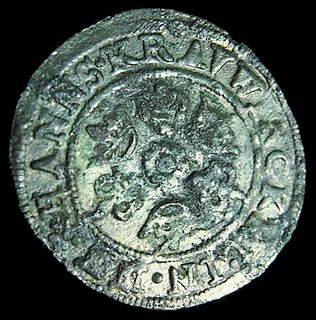
PREV ARTICLE
NEXT ARTICLE
FULL ISSUE
PREV FULL ISSUE
COINS IN THE EARLY ENGLISH SETTLEMENT AT JAMESTOWN
As noted in the previous article, this 2014 thesis by Dr. Beverly Straube is an extensive study of coinage in the early English
settlement at Jamestown, VA. Here's the Abstract. -Editor
Explicating an Undocumented Fiscal Scheme in the Early English Settlement at Jamestown through the Archaeological Evidence by
Abstract Traditionally, coins and exonumia found in archaeological contexts have been examined in a way that fails to utilize their full potential for making substantive contributions to historical questions. Often bearing dates and/or dateable iconography, these numismatic objects are used primarily to provide temporal data for archaeological contexts or sites; and, as material culture related to the economic sphere, the function of these objects is assumed. When archaeological excavations in England’s North American colonies uncover European coins and exonumia that are obsolete in their original countries of origin, they are often interpreted as items imported for the Indian trade without consideration of their full social and cultural contexts. Since 1994, archaeological excavations on the c. 1607-24 site of James Fort, the initial English settlement at Jamestown, have uncovered over two hundred Dutch and English tokens and Irish coins that are both unusual for the Virginia context and are no longer current in their original settings. This thesis examines this unusual group of base metal coins and exonumia found in the fort’s tightly dated discrete contexts as evidence of an undocumented scheme of token currency in the early English colony. The research incorporates a biographical approach to the data, weaving together numismatic scholarship, evidence from archaeological contexts, and contemporary historical accounts. The use of token currency in Bermuda and Newfoundland, two early English colonies established subsequent to Jamestown, provides evidence of parallel adaptive measures required to fulfil local needs in New World settlements. In conclusion, familial and commercial links connecting the leaders of the Virginia enterprise, English governmental officials, and the Royal Mint are suggested as agencies for the obsolete coins and tokens at Jamestown. Using numismatic objects as portals to Jamestown’s past, this study demonstrates new understandings may be gained from beginning an historical inquiry with contextually relevant material culture. 
A brass Nuremberg jetton of Hans Krauwinckel II To read the complete thesis, see:
Wayne Homren, Editor The Numismatic Bibliomania Society is a non-profit organization promoting numismatic literature. See our web site at coinbooks.org. To submit items for publication in The E-Sylum, write to the Editor at this address: whomren@gmail.com To subscribe go to: https://my.binhost.com/lists/listinfo/esylum All Rights Reserved. NBS Home Page Contact the NBS webmaster 
|